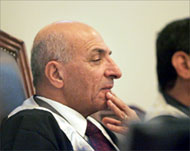Timeline: Saddam’s Dujail trial
Saddam Hussein has been found guilty of crimes against humanity and sentenced to death at the end of the first of two trials brought against him over his actions during his time as Iraqi president.

October 19, 2005: Saddam is charged with crimes against humanity over the killing of 148 Shia men in the town of Dujail after an assassination attempt against him in 1982. The former president pleads not guilty at the Iraqi Special Tribunal in Baghdad.
October 20: Masked gunmen kidnap Saadoun al-Janabi, the lawyer for Awad al-Bander, one of Saddam’s seven co-defendants. His body is found the next day with bullet holes in the head.
November 8: Adel Mohammed Abbas, the lawyer for Taha Yassin Ramadan, Saddam’s former deputy is found murdered in Baghdad. Tamer Hammud, lawyer for co-accused Barzan al-Tikriti, is wounded and flees the country.
November 9: Saddam’s entire defence team questions the legitimacy of the court, which has been renamed the Iraqi High Tribunal.
November 28: The court hears first testimony from a prosecution witness after a 40-day break. He and two other defendants complain about their treatment.
December 4: One of the five judges trying the case steps down after learning that one of the defendants may have been involved in his brother’s execution.
December 5: Two witnesses tell of mass arrests, torture and killings in Dujail. Defence lawyers walk out after being denied right to challenge court’s legitimacy.
 |
|
Al-Rahman took over as chief |
December 7: Saddam stays away from the hearing after saying “I will not come to an unjust court … go to hell” the day before.
January 15, 2006: Chief judge Rizkar Mohammed Amin, a Kurd, resigns after complaints by Shia politicians that he had failed to keep control of court proceedings.
January 23: The court appoints a new interim chief judge, Rauf Abd al-Rahman.
February 28: Prosecutors submit what they say is a signed execution order showing Saddam’s guilt in the killings.
March 1: Saddam accepts for the first time in court that he ordered the trial of Shia suspects implicated in the assassination attempt against him.
March 15: Saddam calls for Iraqis to join the “resistance” and dismisses his trial as a “comedy”. Former secret police chief Barzan al-Tikriti denies involvement in the Dujail massacre.
April 4: Saddam defends his decision to put the Dujail suspects on trial.
April 17: Experts confirm the authenticity of Saddam’s signature on documents implicating him in the massacre.
May 15-17: Saddam refuses to enter a plea as charges are formally presented. The other defendants say they are not guilty. Saddam insists he is still Iraq’s president.
June 19: During their closing statements the prosecutors ask the judge for death sentences for Saddam and three of co-accused.
June 21: A third defence lawyer, Khamis al-Obeidi, is murdered. The following day Saddam stages a one-day hunger strike in protest.
July 23: Saddam is hospitalised on the 17th day of a hunger strike and fed through a tube.
July 26: Court-appointed lawyer makes final arguments for the defence because Saddam’s team is boycotting the hearings. Saddam asks to be shot rather than hanged if convicted.
July 27: Dujail trial adjourns.
November 5: Saddam and two of his co-defendants are found guilty of crimes against humanity and sentenced him to hang.
The death sentence means an automatic appeal to a nine-member appeals chamber. The sentence must be carried out within 30 days of all appeals being exhausted. Iraq’s president and two vice-presidents must ratify the death sentence before it is carried out.
Iraqi law states that the corpse of someone who is executed is handed over to their family. If they don’t claim the body it will be buried without a funeral at the government’s expense.